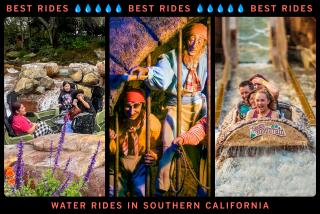Rafting in the Tropical Wilds of Costa Rica
- Share via
SAN JOSE, Costa Rica — You’re gliding quietly down the river, basking in the surrealistic beauty of a verdant tropical jungle. The shore is lined with lush green ferns, punctuated by the brilliant colors of wild orchids. Monkeys caper in the trees overhead, and brightly colored toucans and parrots soar from branch to branch.
Then there’s a rush of adrenaline as the inflatable raft is sucked into a powerful rapid that launches it into one of nature’s most exciting and exhilarating rides.
World attention has focused on this tiny Central American nation since President Oscar Arias Sanchez was awarded the 1987 Nobel Peace prize. Travelers have become increasingly aware of Costa Rica’s tourist attractions, including an ideal climate, incredible scenery, a mind-boggling variety of tropical flowers and exotic birds, a world-famous system of national parks and wildlife preserves, some of the world’s best fishing and idyllic beaches.
Not as well known, however, is that Costa Rica also offers some of the world’s best white-water river rafting.
Tropical Wilderness
Wild and untamed, the rivers plunge through spectacularly beautiful, largely unexplored tropical wilderness areas. Rivers compare favorably to California’s Tuolumne and Idaho’s famous Middle Fork of the Salmon.
The Chirripo, for example, drops 50 feet a mile and produces more than 100 top-class rapids in the first 40 miles.
“They come so hot and heavy that we’ve never been able to keep accurate count,” said white-water expert Michael S. Kaye, whose Costa Rica Expeditions pioneered white-water rafting and nature tours here nearly 10 years ago.
These big, exciting rivers plunge through canyons that slice across virgin jungle. Waterfalls cascade down the slopes of surrounding mountains, and wildlife is abundant--big iguanas sunning themselves on the rocks, otters playing in river pools, tapir, jaguar, ocelot, deer and hundreds of varieties of birds.
(Costa Rica has more species of birds than all of the continental United States and Canada combined.)
For Serious Rafters
Costa Rica’s ideal weather (daily highs in the capital city of San Jose are in the 70s) allows year-around rafting, even in the rainy season, which generally runs from late May through November.
It is during the rainy season, when the rivers are at their highest and wildest, that the serious rafters and kayakers come to Costa Rica.
Three principal rafting rivers are the Pacuare, Reventazon and Chirripo.
The Pacuare tumbles from the Talamanca Mountains east of San Jose and empties into the Caribbean. With conditions suitable for rafting all year, the Pacuare offers spectacular two- or three-day trips in virgin jungle as the river rushes through steep, forested canyons.
The Reventazon (Spanish for bursting ) offers something for everyone with one-day runs of varying difficulty. The upper run is for those in good shape and highly motivated. In the first three miles the river drops 125 feet a mile. It’s virtually one constant rapid.
A recently discovered lower run on the Reventazon is even more challenging, offering nine miles of continuous Class V action.
(Rivers are rated by classes from I to VI, with Class I little more than a current and Class VI rivers designated as those run “only by a team of experts, with serious risk to equipment and team members.”)
Safe But Not Boring
The middle run of the Reventazon is fine for children 8 or 10, as well as for older folks and beginners. “It’s safe but not boring, with enough rapids and water to provide excitement,” Kaye said.
Costa Rica Expeditions offers these one-day runs for $65. The trip starts in San Jose at 7:30 a.m. with a 40-mile drive to the river, where boats are put into the water for the four-hour rafting expedition.
A gourmet lunch served on the bank of the river is included, and rafters are returned to their hotel in time for dinner.
The Chirripo is bigger and wider and flows with more power than the Pacuare, but because the chutes are not as narrow and tricky it is not as difficult to negotiate.
Nevertheless, waves up to 15 feet and flows that reach to more than 15,000 cubic feet a second provide incredible excitement.
Prices of the trips are from $72 to $86 a day, including tents, camping, carrying equipment and meals.
A nine-day trip costs $641 for three days of rafting on the Pacuare River, one day on the Upper Reventazon, another day on the Lower Reventazon, a tour of Poas Volcano, one day free, lodging, most meals and transfers. Air fare to Costa Rica is extra.
Paddle Power
Guides are trained in the United States, and all rafts are fully equipped with U.S. Coast Guard-approved safety equipment.
The expeditions offer various ways of enjoying the rivers. Paddle boats are for those in reasonably good shape. The guide acts as the rudder while the rafters (four to eight per boat) provide the paddle power.
Oar boats, which carry the baggage, are for one to four people, with the guide providing the steering and power with 10-foot oars mounted on a metal frame. Kayaks are available for experienced paddlers.
There’s always a chance for an unscheduled swim, but Costa Rica’s rivers are a pleasant 70 degrees and considerably safer than most North American rivers that can be a cold 40 degrees.
Costa Rica is a peaceful nation of fewer than 3 million people, between Nicaragua to the north and Panama to the south. It’s narrower than 100 miles from ocean to ocean in some places, and on a clear day from a mountaintop you can see both the Pacific Ocean and the Caribbean.
Besides river rafting, there are natural history tours (Costa Rica is a world center for research in tropical biology) to national parks and preserves, jungle tours, visits to the tops of the nation’s many volcanoes and the kind of fishing that most anglers only dream about.
Some of the most exciting fishing is in Tortuguero National Park’s hidden backwaters and lagoons on the Caribbean Coast, where Tortuga Lodge offers overnight tours by plane from San Jose to explore the wildlife of the park’s backwaters and lagoons, or longer trips to battle huge tarpon, snook and other game fish.
Fishing for Trout
There also are one-day and overnight trips for trout in the middle of a tropical jungle on the Rio Savegre, where at 8,000 feet the river passes clear and cold through the ranch of Efrain Chacon, who with his family has been catering to trout enthusiasts for 12 years.
Lacsa, Costa Rica’s national airline, has five flights a week to San Jose from Los Angeles. Mexicana, Pan American and Eastern Airlines also fly to San Jose.
For information on Costa Rica’s river rafting, natural history tours or fishing, write to Costa Rica Expeditions, P.O. Box 6941, San Jose, Costa Rica. Or contact tour organizer, Sobek Expeditions, 1 Sobek Tower, Angels Camp, Calif. 95222, phone (800) 344-3284.
More to Read
Sign up for The Wild
We’ll help you find the best places to hike, bike and run, as well as the perfect silent spots for meditation and yoga.
You may occasionally receive promotional content from the Los Angeles Times.






